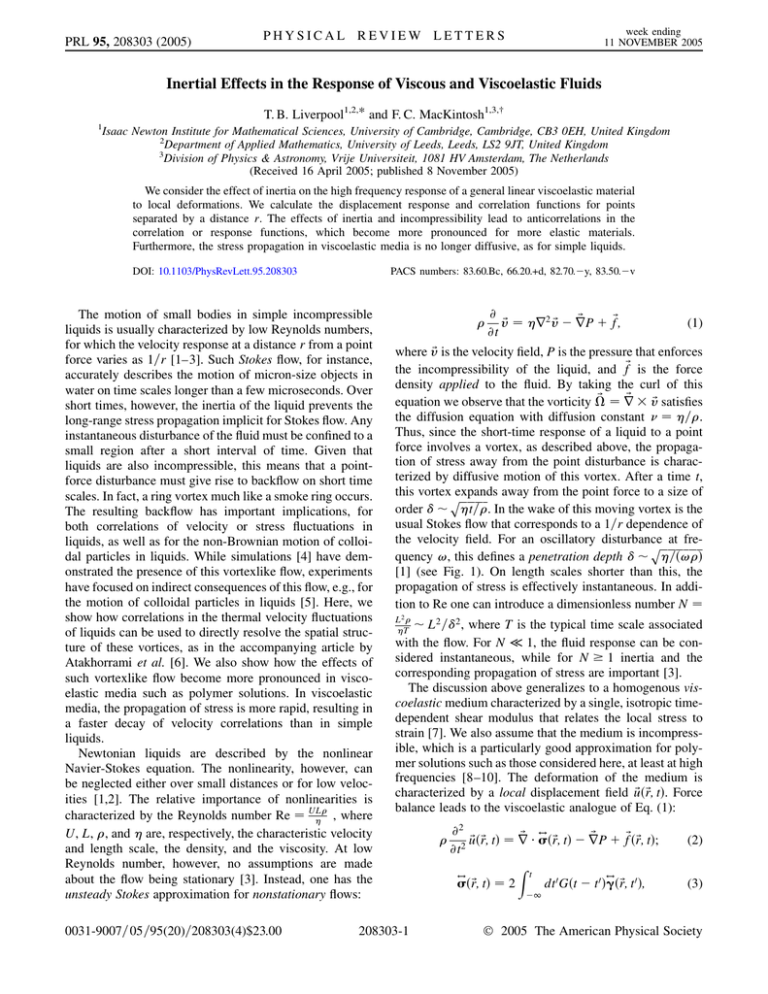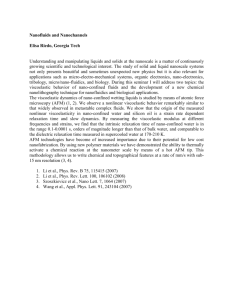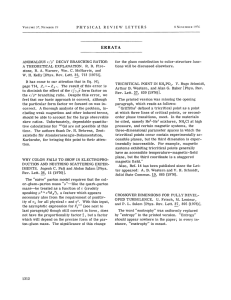Inertial Effects in the Response of Viscous and Viscoelastic Fluids
advertisement

PRL 95, 208303 (2005) week ending 11 NOVEMBER 2005 PHYSICAL REVIEW LETTERS Inertial Effects in the Response of Viscous and Viscoelastic Fluids T. B. Liverpool1,2,* and F. C. MacKintosh1,3,† 1 Isaac Newton Institute for Mathematical Sciences, University of Cambridge, Cambridge, CB3 0EH, United Kingdom 2 Department of Applied Mathematics, University of Leeds, Leeds, LS2 9JT, United Kingdom 3 Division of Physics & Astronomy, Vrije Universiteit, 1081 HV Amsterdam, The Netherlands (Received 16 April 2005; published 8 November 2005) We consider the effect of inertia on the high frequency response of a general linear viscoelastic material to local deformations. We calculate the displacement response and correlation functions for points separated by a distance r. The effects of inertia and incompressibility lead to anticorrelations in the correlation or response functions, which become more pronounced for more elastic materials. Furthermore, the stress propagation in viscoelastic media is no longer diffusive, as for simple liquids. DOI: 10.1103/PhysRevLett.95.208303 PACS numbers: 83.60.Bc, 66.20.+d, 82.70.y, 83.50.v The motion of small bodies in simple incompressible liquids is usually characterized by low Reynolds numbers, for which the velocity response at a distance r from a point force varies as 1=r [1–3]. Such Stokes flow, for instance, accurately describes the motion of micron-size objects in water on time scales longer than a few microseconds. Over short times, however, the inertia of the liquid prevents the long-range stress propagation implicit for Stokes flow. Any instantaneous disturbance of the fluid must be confined to a small region after a short interval of time. Given that liquids are also incompressible, this means that a pointforce disturbance must give rise to backflow on short time scales. In fact, a ring vortex much like a smoke ring occurs. The resulting backflow has important implications, for both correlations of velocity or stress fluctuations in liquids, as well as for the non-Brownian motion of colloidal particles in liquids. While simulations [4] have demonstrated the presence of this vortexlike flow, experiments have focused on indirect consequences of this flow, e.g., for the motion of colloidal particles in liquids [5]. Here, we show how correlations in the thermal velocity fluctuations of liquids can be used to directly resolve the spatial structure of these vortices, as in the accompanying article by Atakhorrami et al. [6]. We also show how the effects of such vortexlike flow become more pronounced in viscoelastic media such as polymer solutions. In viscoelastic media, the propagation of stress is more rapid, resulting in a faster decay of velocity correlations than in simple liquids. Newtonian liquids are described by the nonlinear Navier-Stokes equation. The nonlinearity, however, can be neglected either over small distances or for low velocities [1,2]. The relative importance of nonlinearities is characterized by the Reynolds number Re UL , where U, L, , and are, respectively, the characteristic velocity and length scale, the density, and the viscosity. At low Reynolds number, however, no assumptions are made about the flow being stationary [3]. Instead, one has the unsteady Stokes approximation for nonstationary flows: 0031-9007=05=95(20)=208303(4)$23.00 @ ~ f; ~ v~ r2 v~ rP @t (1) where v~ is the velocity field, P is the pressure that enforces the incompressibility of the liquid, and f~ is the force density applied to the fluid. By taking the curl of this ~ v~ satisfies ~ r equation we observe that the vorticity the diffusion equation with diffusion constant =. Thus, since the short-time response of a liquid to a point force involves a vortex, as described above, the propagation of stress away from the point disturbance is characterized by diffusive motion of this vortex. After a time t, this vortex expands away from the point force to a size of p order t=. In the wake of this moving vortex is the usual Stokes flow that corresponds to a 1=r dependence of the velocity field. For an oscillatory disturbance at frep quency !, this defines a penetration depth =! [1] (see Fig. 1). On length scales shorter than this, the propagation of stress is effectively instantaneous. In addition to Re one can introduce a dimensionless number N L2 T L2 =2 , where T is the typical time scale associated with the flow. For N 1, the fluid response can be considered instantaneous, while for N 1 inertia and the corresponding propagation of stress are important [3]. The discussion above generalizes to a homogenous viscoelastic medium characterized by a single, isotropic timedependent shear modulus that relates the local stress to strain [7]. We also assume that the medium is incompressible, which is a particularly good approximation for polymer solutions such as those considered here, at least at high frequencies [8–10]. The deformation of the medium is ~ r; t. Force characterized by a local displacement field u~ balance leads to the viscoelastic analogue of Eq. (1): 208303-1 @2 $ ~ ~ f~ ~ r; t; ~ r; t r u~ ~r; t rP 2 @t $ ~r; t 2 Zt $ dt0 Gt t0 ~r; t0 ; (2) (3) 1 © 2005 The American Physical Society PRL 95, 208303 (2005) PHYSICAL REVIEW LETTERS week ending 11 NOVEMBER 2005 pendicular to r~. (These are illustrated in Figs. 2 and 3.) The parallel response function k , for instance, is obtained from the inverse Fourier transform of Eq. (4), where ~ represents the angle between r~ and k: k r; ! Z k2 dk sind 1 cos2 eikr cos : 22 Gk2 !2 (5) A similar calculation yields ? r; !. The response functions for general G! are given by p k r; ! k r =4Gr; (6) FIG. 1. The velocity response of a Newtonian fluid for parallel and perpendicular motion. The solid lines show the in-phase (real) velocity response, which decays on the scale of the penetration depth. The dashed lines show the out-of-phase velocity response (specifically, !0 ). In the noninertial limit of small r, the Oseen tensor is recovered, for which the (velocity) response is real. The decay of the various components of the response illustrates the finite penetration depth for the response. The strong dip in the perpendicular response is a manifestation of the vortexlike flow at short times. $ $ ~ u~ r ~ u ~ y is where is the local stress tensor, 12 r the local deformation tensor, and the time dependence of the viscoelastic response is encoded in the memory function, Gt [7]. Causality requires that stress at time t depends only on earlier states of strain, which limits the range of integration above. Incompressibility leads to the ~ u~ 0. constraint r Equations (2) and (3) can be simplified by a decomposition of the force density and displacement into Fourier components. Taking spatiotemporal Fourier transforms R R ~ ! d3 r 1 dtei!tk ~ r~ u ~ k; ~ r; ~ t, and dedefined as u 1 0 ! iG00 ! fining the complex modulus G! G R1 i!t 0 dte Gt, we can eliminate the pressure by imposing incompressibility in Eqs. (2) and (3). This leads to 1 k^ k^ ~ ! ~ k; ~ !; ~uk; f (4) G!k2 !2 ~ where k^ k=jkj. We invert this Fourier transform to obtain the displacement response function due to a point force applied at the origin. The linear response of the medium at a distance r~ is in general characterized by a tensor, since both force and response (displacement field) are vectors: ui ~r; ! ~ !, where ij 0ij i00ij is complex. ij r~; !fj 0; Given our assumptions of homogeneity and isotropy, the displacement field must lie in a plane common to both r~ ~ By rotational and translational symmetry and the force f. there are only two distinct contributions to the response function. These are (1) a parallel response that is given by a displacement field u~ parallel to both f~ and r~, and (2) a perpendicular response given by u~ parallel to f~ and per- p ? r; ! ? r =8Gr; (7) where !2 =G is complex and k x 21 ixeix 1=x2 ; (8) ? x 21 x2 1 ixeix =x2 : (9) The magnitude of defines the inverse (viscoelastic) penetration depth . We have written these response functions in a form in which the noninertial limits (x ! 0) are simple: k;? ! 1. Thus, for instance, for a simple liquid, for which G! i!, the limit x ! 0 reduces to a displacement response consistent with the (timeindependent) Oseen tensor [2,11] and for finite x, these response functions give the dynamic Oseen tensor [11,12]. FIG. 2. The parallel response for viscoelastic media with z , where z 1=2, 3=4, 1. For reference, the G! gi! response function for a Newtonian liquid (z 1) is shown in gray. In each case, z 3=4 is intermediate between z 1 and z 1=2. Both real (a) and imaginary (b) parts are shown. 208303-2 PRL 95, 208303 (2005) PHYSICAL REVIEW LETTERS week ending 11 NOVEMBER 2005 1 1 i!k;? ) approach 4r and 8r for a unit force at the origin. These then decay for r * . Here, the region of negative response in the perpendicular case corresponds to the backflow of the vortex. The response functions above represent the equilibrium displacements due to forces acting in the medium. These response functions also govern the equilibrium thermal fluctuations and the correlated fluctuations from point to point within the medium. The relationship between thermal fluctuations and response is described by the fluctuation-dissipation theorem. Specifically, for points separated by a distance r along the x^ direction, Ck;? r; ! FIG. 3. The perpendicular response for viscoelastic media with z 1=2, 3=4, 1. Again, the response for a Newtonian liquid is shown in gray, and the case of z 3=4 is intermediate between z 1 and z 1=2. Both real (a) and imaginary (b) parts are shown. This is also shown in Fig. 1, where for small r= the parallel and perpendicular velocity response (i.e., Ck r; ! Z d! i!k r; ! 2? r; !ei!jtj : 2 (12) (10) R1 i!t where CR and k r; ! 1 dte hux 0; 0ux r; ti 1 i!t C? r; ! 1 dte huy 0; 0uy r; ti. An experimentally pertinent illustration is given by the high frequency complex shear modulus of a polymer soluz tion, G! i! gi! which has both solvent and polymer contributions. Assuming that the polymers dominate the shear modulus leads to the simple scaling z [13]. For the Rouse model of flex form G! ’ gi! ible polymers z 1=2 [14], while for semiflexible polymers z 3=4 [9,15,16]. These cases are shown in Figs. 2 and 3. We see that the oscillatory or anticorrelated response becomes more pronounced in viscoelastic materials. Further simplification of Eq. (10) using the definitions in Eqs. (8) and (9) leads, e.g., to kB T 2 sinz=4 z z z z sin cos cos cos cos ; 1 sin e 2 2!jGjr 4 4 4 4 p where r !2 =jGj. The displacement field exhibiting the vortex pattern is shown in Fig. 4 for a point force at the origin pointed along the x axis. We note the strict inversion symmetries of this flow: vx (vy ) is symmetric (antisymmetric) for either x ! x or y ! y, as can be seen by the fact that the (linear) response must everywhere reverse if the direction of the force is reversed. The self-sustaining backflow represented in Fig. 4 gives rise to long-lived correlations that, for instance, affect the crossover from ballistic to diffusive motion of a particle in a liquid. For a simple liquid, the ~ t v0; ~ 0i decay fluid velocity (auto)correlations hv0; 3=2 proportional to jtj . This is known as the long-time tail [4,5,17]. For a viscoelastic fluid, stress propagation is faster than diffusive, resulting in a more rapid decay of velocity correlations. The decay is, however, still alge~ 0 vr; ~ ti braic. The velocity correlation function hv0; is given by kT 2kB T 00 k;? r; !; ! (11) By taking the limit r ! 0, we find that this correlation function decays as jtj , where 32 z=2 for G !z as above. The principal effect of inertia in the response of viscoelastic media as well as liquids is the finite propagation of stress. This is more precisely characterized by the penetration depth . More microscopically, the manifestation of inertia is the vortexlike flow or displacement field, which appears both in the equilibrium response at a distance, as well as in the correlations of fluctuations about thermal equilibrium. It is because of the latter correlations of thermal fluctuations that an important indirect consequence of the vortex has been observed: the long-time tail in the crossover between ballistic and Brownian motion of particles in simple liquids [5,17]. Nevertheless, no direct experimental observation of this vortex and resulting backflow has been made. Recent advances in combined two-particle tracking and manipulation at high frequencies [18,19] make possible the direct observation of such fundamental fluid dynamics. Specifically, since the penetration depth is of order micro- 208303-3 PRL 95, 208303 (2005) PHYSICAL REVIEW LETTERS † FIG. 4. The displacement field displays a clear vortexlike structure. Here, a force in the x^ direction is applied at the origin (as shown by the filled circle and arrow). Distances are shown in p units of the penetration depth jGj=!2 . This example has been calculated for the Rouse model with z 1=2. meters in ordinary water at now accessible frequencies of order kilohertz, two-particle tracking, either for active or passive/thermal motion, should be able to detect the underlying hydrodynamic/inertial response or correlations [6]. We emphasize, however, that these high frequency inertial effects are distinct from lower frequency correlations due to an imposed external potential (such as an optical trap) [18,20] that are not inertial in origin. Interestingly, we also see above how for viscoelastic media the correlations, and specifically the oscillatory character of the response functions, become much more pronounced with increasing elastic component of the shear modulus. This difference can in principle be used to characterize the high frequency viscoelastic response of a particular material [6]. We thank D. Frenkel, D. Lubensky, W. Poon, and W. van Saarloos for helpful conversations. We especially wish to acknowledge frequent discussions with M. Atakhorrami, G. Koenderink, D. Mizuno, and C. Schmidt. *Electronic address: t.b.liverpool@leeds.ac.uk week ending 11 NOVEMBER 2005 Electronic address: fcm@nat.vu.nl [1] L. D. Landau and E. M. Lifshitz, Fluid Mechanics (Butterworth-Heinemann, Oxford, 2000). [2] J. Happel and H. Brenner, Low Reynolds Number Hydrodynamics, (McGraw-Hill, New York, 1963). [3] E. Guyon et al., Physical Hydrodynamics (Oxford University Press, New York, 2001). [4] B. J. Alder and T. E. Wainwright, Phys. Rev. A 1, 18 (1970). [5] G. L. Paul and P. N. Pusey, J. Phys. A 14, 3301 (1981); D. A. Weitz, D. J. Pine, P. N. Pusey, and R. J. A. Tough, Phys. Rev. Lett. 63, 1747 (1989). [6] M. Atakhorrami, G. H. Koenderink, C. F. Schmidt, and F. C. MacKintosh, this issue, Phys. Rev. Lett. 95, 208302 (2005). [7] R. B. Bird, R. C. Armstrong, and O. Hassager, Dynamics of Polymeric Liquids (Wiley, New York, 1987). [8] F. Brochard and P. G. de Gennes, Macromolecules 10, 1157 (1977); S. T. Milner, Phys. Rev. E 48, 3674 (1993). [9] F. Gittes, B. Schnurr, P. D. Olmsted, F. C. MacKintosh, and C. F. Schmidt, Phys. Rev. Lett. 79, 3286 (1997); B. Schnurr, F. Gittes, F. C. MacKintosh, and C. F. Schmidt, Macromolecules 30, 7781 (1997). [10] A. J. Levine and T. C. Lubensky, Phys. Rev. E 63, 041510 (2001). [11] C. W. Oseen, Hydrodynamik (Akademische Verlagsgesellschaft, Leipzig, 1927), p. 47. [12] D. Bedeaux and P. Mazur, Physica (Amsterdam) 76, 235 (1974); 76, 247 (1974). [13] We note that at high frequencies the solvent (viscous) contribution to the modulus must be included in order to make accurate comparisons with experiment [6]. [14] M. Doi and S. F. Edwards, The Theory of Polymer Dynamics (Oxford University Press, New York, 1986). [15] D. C. Morse, Macromolecules 31, 7030 (1998); 31, 7044 (1998); Phys. Rev. E 58, R1237 (1998). [16] F. Gittes and F. C. MacKintosh, Phys. Rev. E 58, R1241 (1998). [17] R. Zwanzig and M. Bixon, Phys. Rev. A 2, 2005 (1970); M. H. Ernst, E. H. Hauge, and J. M. J. van Leeuwen, Phys. Rev. Lett. 25, 1254 (1970); J. R. Dorfman and E. G. D. Cohen, Phys. Rev. Lett. 25, 1257 (1970); D. Bedeaux and P. Mazur, Phys. Lett. 43A, 401 (1973); Physica (Amsterdam) 73, 431 (1974). [18] J.-C. Meiners and S. R. Quake, Phys. Rev. Lett. 82, 2211 (1999). [19] J. C. Crocker, M. T. Valentine, E. R. Weeks, T. Gisler, P. D. Kaplan, A. G. Yodh, and D. A. Weitz, Phys. Rev. Lett. 85, 888 (2000). [20] S. Henderson, S. Mitchell, and P. Bartlett, Phys. Rev. E 64, 061403 (2001). 208303-4



